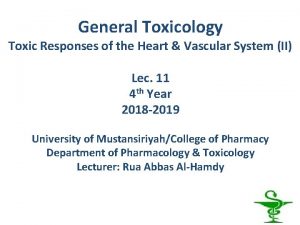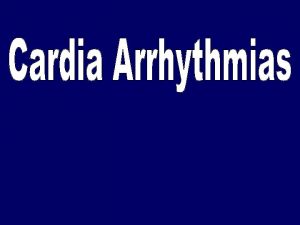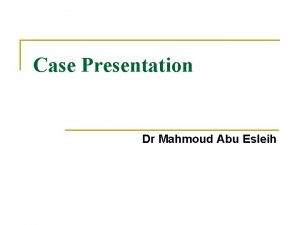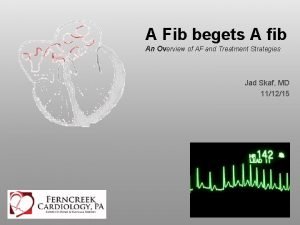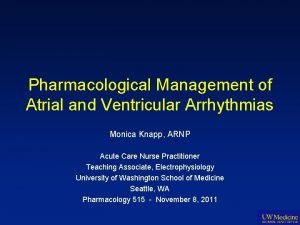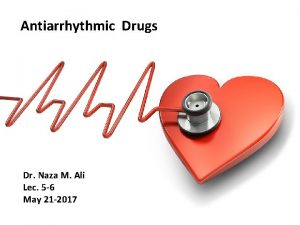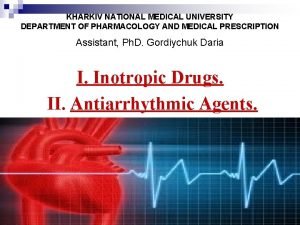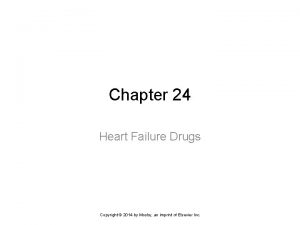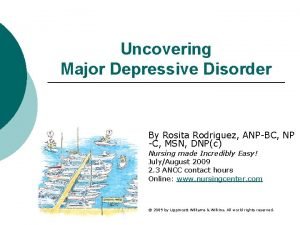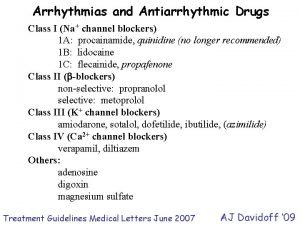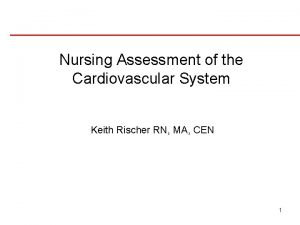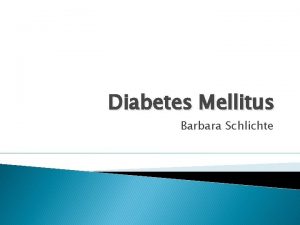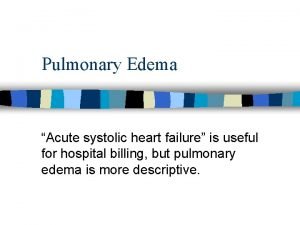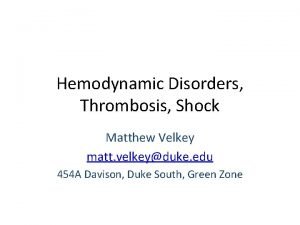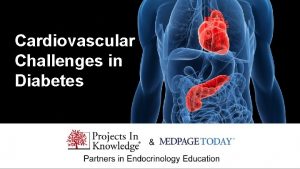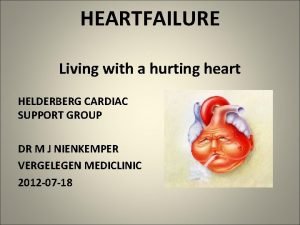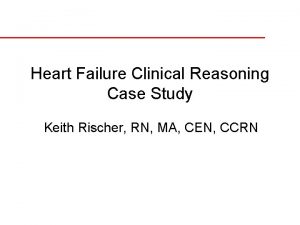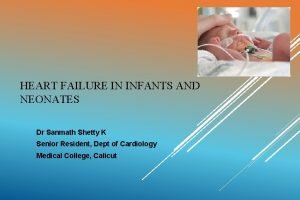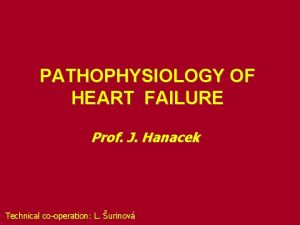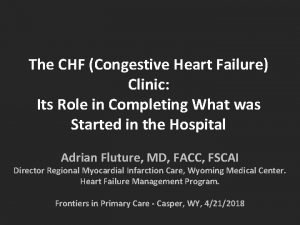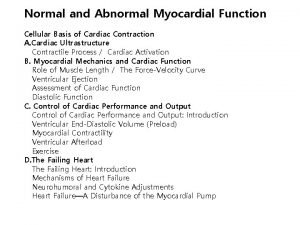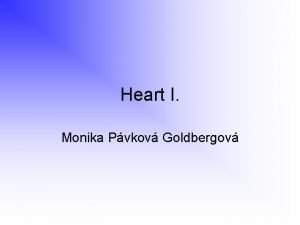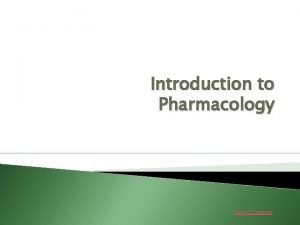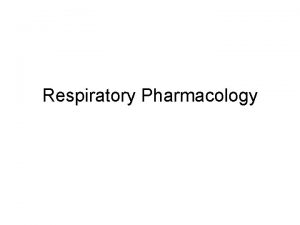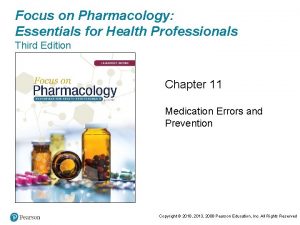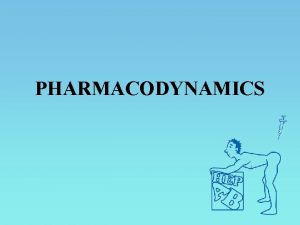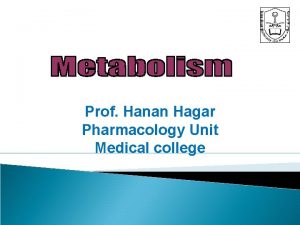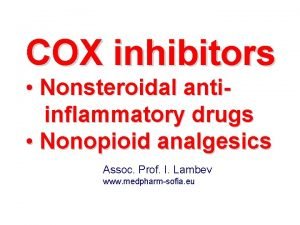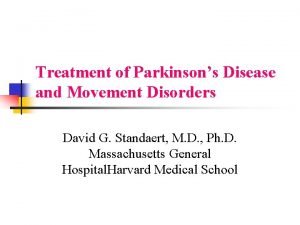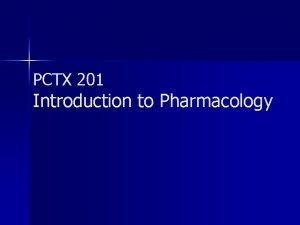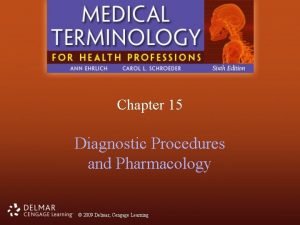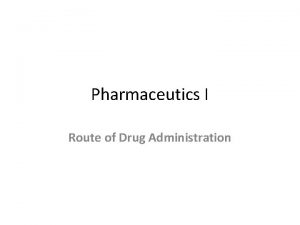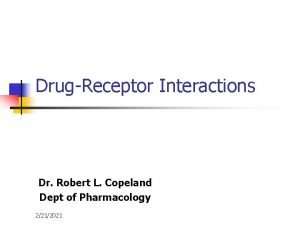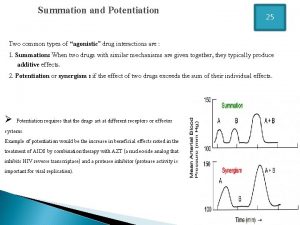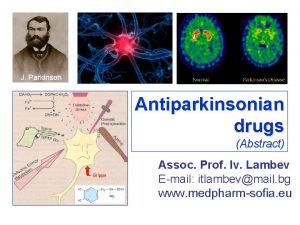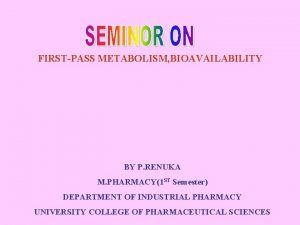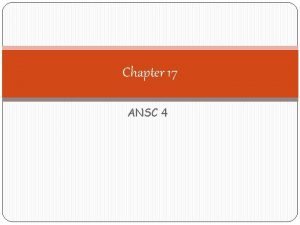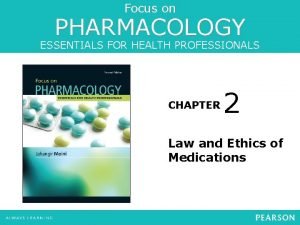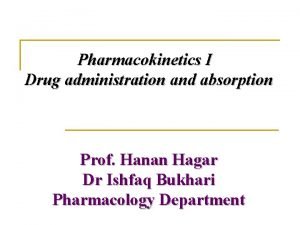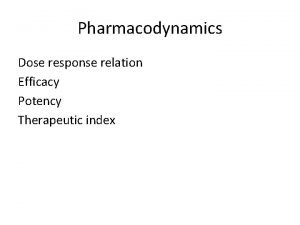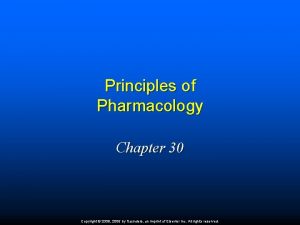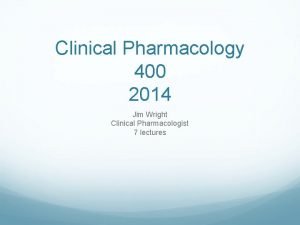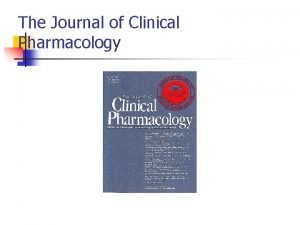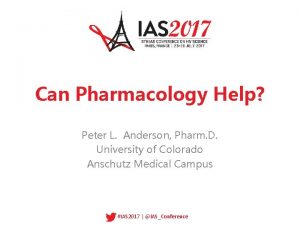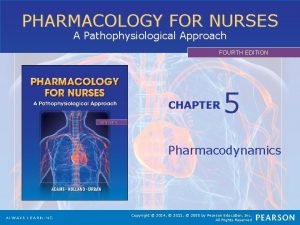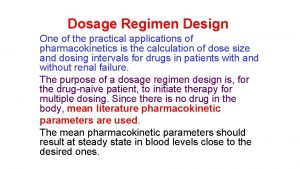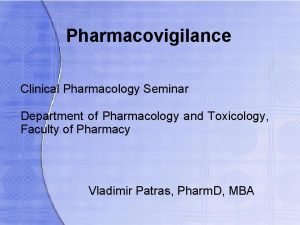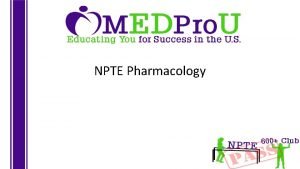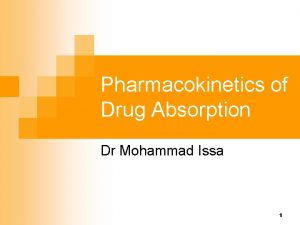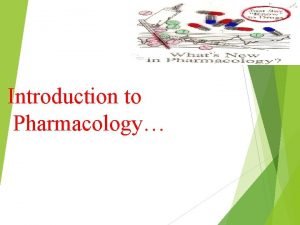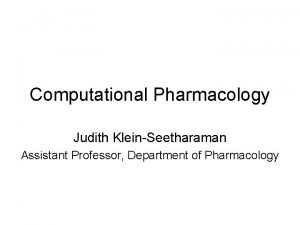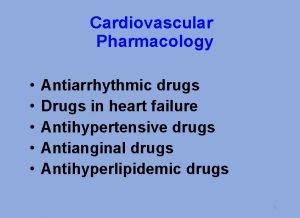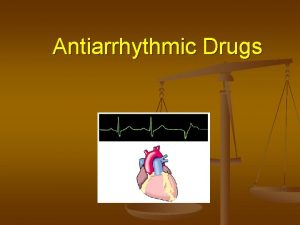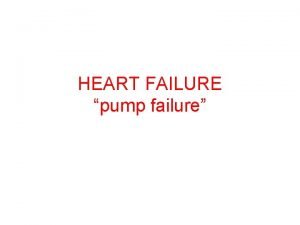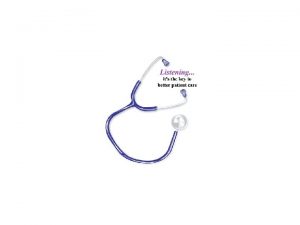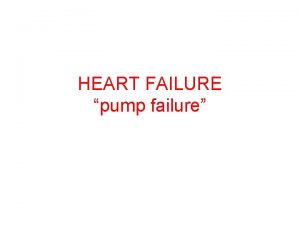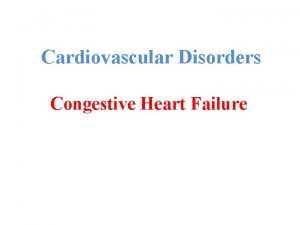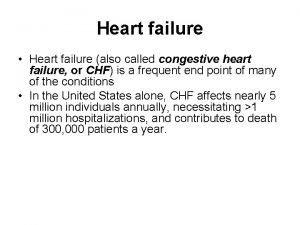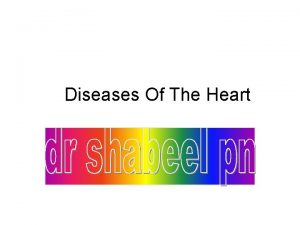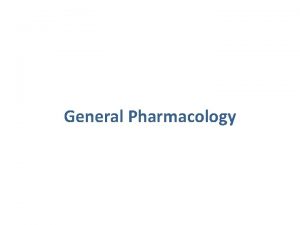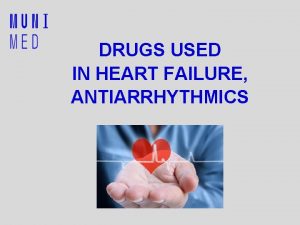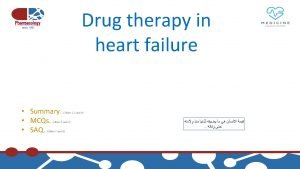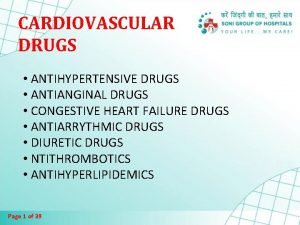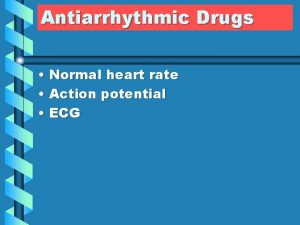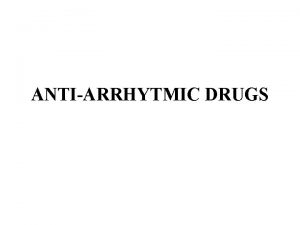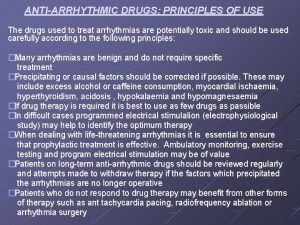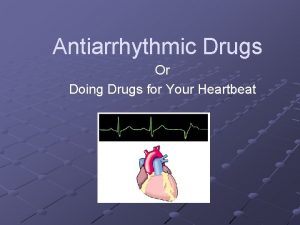Cardiovascular Pharmacology Antiarrhythmic drugs Drugs in heart failure





































































- Slides: 69

Cardiovascular Pharmacology • • • Antiarrhythmic drugs Drugs in heart failure Antihypertensive drugs Antianginal drugs Antihyperlipidemic drugs

Antiarrhythmic Drugs Prof. Abdulrahman Almotrefi

Learning objectives By the end of this lecture, students should be able to: - Understand definition of arrhythmias and their different types - describe different classes of Antiarrhythmic drugs and their mechanism of action - understand their pharmacological actions, clinical uses, adverse effects and their interactions with other drugs.


CARDIAC CONDUCTION SYSTEM - S. A. node - Inter-nodal pathways - A. V. node - Bundle of His and branches - Purkinje fibers

Electrocardiogram (ECG)

CARDIAC ACTION POTENTIAL


CARDIAC ACTION POTENTIAL Non-pacemaker (ventricular muscle)

CARDIAC ACTION POTENTIAL Pacemaker (SA node)

Difference between pacemaker and non-pacemaker action potential 11

WHAT IS ARRHYTHMIA? An abnormality in the : ■ rate . . . . high= tachycardia low = bradycardia




WHAT IS ARRHYTHMIA? An abnormality in the: ■ rate . . . . high= tachycardia low = bradycardia ■ regularity. . . Extrasystoles ( PAC, PVC )



WHAT IS ARRHYTHMIA? An abnormality in the : ■ rate . . . . high= tachycardia low = bradycardia ■ regularity. . . extrasystoles ■ site of origin. . . ectopic pacemakers ■ or disturbance in conduction

Disturbances in conduction 20

Therapeutic use of antiarrhythmic drugs The ultimate goal of therapy Restore normal rhythm & conduction Maintenance of Prevention of more normal rhythm serious arrhythmias 21

How antiarrhythmic drugs produce these effects? • Slow conduction velocity • Altering the excitability of cardiac cells by prolonging the effective refractory period • Suppressing ectopic pacemaker activity by inhibiting phase 4 slow depolarization

CLASSIFICATION OF ANTIARRHYTHMIC DRUGS

Vaughn Williams classification CLASS I Na+ channel blockers ( membrane stabilizing drugs) CLASS II: β- adrenoceptor blockers CLASS III: Drugs that prolong action potential duration CLASS IV: Calcium channel blockers

CLASS I Drugs that block the influx of Na ions through Na channels 1 - decrease the rate of rise of rapid depolarization (Phase O) 2 - decrease phase 4 slow depolarization (suppress pacemaker activity) (membrane stabilizing effect)

CLASS I • Sub classified according to their effect on action potential duration : - Ia : prolong action potential duration - Ib : shorten action potential duration - Ic : no effect on action potential duration 26

CLASS I a Ia : prolong action potential duration e. g. Quinidine Procainamide


CLASS I a QUINIDINE Other pharmacological actions : 1 - Anticholinergic effect: Increase conduction through the A. V. node ( risk of ventricular tachycardia ) 2 - α-adrenergic blocking effect: may cause vasodilatation & reflex sinus tachycardia ( seen more after I. V. dose ) 3 - ECG changes: - prolongs P-R and Q-T interval - widens QRS complex

CLASS I a QUINIDINE Therapeutic uses: - atrial flutter & fibrillation - maintaining sinus rhythm after cardioversion

CLASS Ia QUINIDINE Adverse effects : quinidine syncope: episodes of fainting due to torsades de pointes (twisting of the spikes) developing at therapeutic plasma levels

Torsades de pointes - may terminate spontaneously or lead to fatal ventricular fibrillation 32

CLASS I a QUINIDINE Adverse effects : v Anticholinergic adverse effects: - Dry mouth - Blurred vision - Urinary retention - constipation v Hypotension - due to depressing contractility & vasodilatation GIVEN ORALLY ( Rarely given I. V. )

CLASS I a PROCAINAMIDE Similar to quinidine except : 1 - less toxic on the heart. . . can be given I. V. 2 - more effective in ventricular than in atrial arrhythmias 3 - No anticholinergic or α-blocking actions

CLASS I a PROCAINAMIDE Adverse effects: - In long term therapy it causes reversible lupus erythematosus-like syndrome - Hypotension - Torsades de pointes - Hallucination & psychosis

CLASS I b • Shorten action potential duration e. g. Lidocaine Mexiletine


CLASS Ib LIDOCAINE Therapeutic uses : treatment of emergency ventricular arrhythmias e. g. : 1 - during surgery 2 - following acute myocardial infarction - NOT effective in atrial arrhythmias - NOT effective orally (3% bioavailability) - given I. V. bolus or slow infusion - t 1/2 = 2 hours

CLASS Ib LIDOCAINE Adverse effects: q hypotension q similar to other local anesthetics, causes CNS adverse effects such as: - paresthesia - tremor - dysarthria (slurred speech) - tinnitus - confusion - convulsions

CLASS Ib MEXILETINE - EFFECTIVE ORALLY Therapeutic uses : 1 - ventricular arrhythmia 2 - digitalis-induced arrhythmias t 1/2 = 10 hours ADVERSE EFFECTS : 1 - nausea , vomiting 2 - tremor , drowsiness, diplopia 3 - arrhythmias & hypotension

CLASS Ic • have no effect on action potential duration e. g. Flecainide


CLASS Ic FLECAINIDE Therapeutic uses : - supraventricular arrhythmias - Wolff-Parkinson-White syndrome - very effective in ventricular arrhythmias, but very high risk of proarrhythmia - should be reserved for resistant arrhythmias

Wolff-Parkinson-White syndrome • Pre-excitation of the ventricles due to an accessory pathway known as the Bundle of Kent.

CLASS Ic FLECAINIDE Adverse effects: 1 - proarrhythmia 2 - CNS : dizziness, tremor, blurred vision, abnormal taste sensations, paraesthesia 3 - heart failure due to -ve inotropic effect

CLASS II DRUGS β- ADRENOCEPTOR BLOCKERS pharmacological actions : block β 1 - receptors in the heart reduce the sympathetic effect on the heart 1 - decrease automaticity of S. A. node and ectopic pacemakers 2 - prolong refractory period ( slow conduction ) of the A. V node

CLASS II DRUGS β- ADRENOCEPTOR BLOCKERS Therapeutic uses : 1 - atrial arrhythmias associated with emotion: e. g. : - after exercise - thyrotoxicosis 2 - WPW 3 - digitalis-induced arrhythmias

CLASS II DRUGS β- ADRENOCEPTOR BLOCKERS Therapeutic uses : Esmolol : - very short acting ( half-life = 9 min. ) - given I. V. for rapid control of ventricular rate in patients with atrial flutter or fibrillation Propranolol, Atenolol, Metoprolol : - used in patients who had myocardial infarction to reduce incidence of sudden death due to ventricular arrhythmias

CLASS III DRUGS • Prolong the action potential duration and refractory period • Prolong phase 3 repolarization


CLASS III DRUGS AMIODARONE pharmacological actions : - prolongs action potential duration and therefore prolongs refractory period ( Main effect ) - additional class Ia, II & IV effects - vasodilating effects ( due to its α- & β-adrenoceptor blocking effects and its calcium channel blocking effects )

CLASS III DRUGS AMIODARONE Therapeutic uses : 1 - main use : serious resistant ventricular arrhythmias 2 - maintenance of sinus rhythm after cardioversion 3 - resistant supraventricular arrhythmias ( e. g. WPW )

CLASS III DRUGS AMIODARONE Adverse effects: - exacerbation of ventricular arrhythmias ( with high dose) - bradycardia and heart failure - pulmonary fibrosis - hyper- or hypothyroidism - photodermatitis & skin deposits ( patients should avoid exposure to the sun)

CLASS III DRUGS AMIODARONE Adverse effects: - Neurological: e. g. tremors and peripheral neuropathy - nausea, vomiting and constipation - corneal micro deposits - hepatocellular necrosis

CLASS III DRUGS AMIODARONE Pharmacokinetics: - extremely long t 1/2 = 13 - 103 DAYS - metabolized by CYP 3 A 4 and CYP 2 C 8 to its major active metabolite: N-desethylamiodarone - eliminated primarily by hepatic metabolism - cross placenta and appear in breast milk

CLASS III DRUGS AMIODARONE Drug Interactions: 1 - Co-administration of amiodarone with drugs that prolong the QT interval increases the risk of Torsades de Points e. g. : macrolide antibiotics ( Clarithromycin, Erythromycin) azole antifungals (Ketoconazole)

CLASS III DRUGS AMIODARONE Drug Interactions: 2 - Drugs (or substances) that inhibit these enzymes Cause increase in serum concentration of amiodarone e. g. : Loratadine, Ritonavir , Trazodone Cimetidine, Grapefruit juice 3 - Drugs that induce these enzymes Cause decrease in serum concentration of amiodarone e. g. : Rifampin

PURE CLASS III Ibutilide • Given by rapid I. V. infusion • Used for the acute conversion of atrial flutter or fibrillation to normal sinus rhythm • Causes QT interval prolongation ( may cause torsades de pointes )

Class 1 V calcium channel blockers Verapamil, Diltiazem • main site of action is A. V. N & S. A. N cause: - slowing of conduction - prolongation of effective refractory period

Class 1 V calcium channel blockers Therapeutic uses : 1 - atrial arrhythmias 2 - re-entry supraventricular arrhythmias e. g. WPW 3 - NOT effective in ventricular arrhythmias

ADENOSINE Mechanism of action : - inhibits c. AMP by binding to adenosine A 1 receptors causing the following actions: 1 - opening of potassium channels (hyperpolarization) 2 - decreasing conduction velocity mainly at AV node ( negative dromotropic effect ) 3 - inhibiting phase 4 pacemaker action potential at SA node ( negative chronotropic effect )


ADENOSINE Therapeutic uses : ■ drug of choice for acute management of paroxysmal supraventricular tachycardia ■ preferred over verapamil (safer and does not depress contractility) half-life = less than 10 sec

ADENOSINE Adverse effects: ■ flushing in about 20% of patients ■ shortness of breath and chest burning in 10% of patients ( due to bronchospasm ) ■ brief AV block (contraindicated in heart block)

New Antiarrhythmic Drugs Dronedarone - a noniodinated congener of amiodarone - has antiarrhythmic properties belonging to all four classes - Used for maintenance of sinus rhythm following cardioversion in patients with atrial fibrillation 65

New Antiarrhythmic Drugs Dronedarone WARNINGS • should not be used in patients with severe (class IV) heart failure. Risk of death may be increased in these patients. • should not be used in patients with permanent atrial fibrillation. Risk of death and stroke, may be increased in these patients. 66

BRADYARRHYTHMIAS ATROPINE ■ used in sinus bradycardia after myocardial infarction and in heart block ■ in emergency heart block isoprenaline may be combined with atropine ( caution )

NONPHARMACOLOGIC THERAPY OF ARRHYTHMIAS Implantable Cardiac Defibrillator (ICD) - can automatically detect and treat fatal arrhythmias such as ventricular fibrillation

Thank you
 Antiarrhythmic drugs mechanism of action
Antiarrhythmic drugs mechanism of action Cardioversion anticoagulation
Cardioversion anticoagulation Svt pregnancy
Svt pregnancy Amiodarone mechanism of action
Amiodarone mechanism of action Af begets af
Af begets af Lidocaine in cardiac arrest
Lidocaine in cardiac arrest Antiarrhythmic drug classes
Antiarrhythmic drug classes Dromotropic effect
Dromotropic effect Chapter 24 heart failure drugs
Chapter 24 heart failure drugs Pharmacology of drugs acting on respiratory system
Pharmacology of drugs acting on respiratory system Adrenal drugs pharmacology
Adrenal drugs pharmacology Cardiovascular drugs
Cardiovascular drugs Non conducted pac ecg
Non conducted pac ecg Failure to sense pacemaker
Failure to sense pacemaker Brittle vs ductile fracture
Brittle vs ductile fracture Digoxin antiarrhythmic class
Digoxin antiarrhythmic class Right ventricular failure
Right ventricular failure Congestive heart failure zones for management
Congestive heart failure zones for management Classification of ejection fraction
Classification of ejection fraction Vetsulin dosage chart for dogs
Vetsulin dosage chart for dogs Cor pulmonale
Cor pulmonale Right sided heart failure
Right sided heart failure Acute vs chronic heart failure
Acute vs chronic heart failure Lmnop heart failure
Lmnop heart failure Heart failure definition
Heart failure definition Heart failure cells are seen in lungs
Heart failure cells are seen in lungs Diabetes and heart failure
Diabetes and heart failure Heart failure complications
Heart failure complications Right vs left-sided heart failure chart
Right vs left-sided heart failure chart Keith rn heart failure case study
Keith rn heart failure case study New york scale heart failure
New york scale heart failure Compensatory mechanisms of heart failure
Compensatory mechanisms of heart failure Heart failure
Heart failure Forrester classification
Forrester classification Heart cross section
Heart cross section Ecg findings of heart failure
Ecg findings of heart failure Nursing assessment for congestive heart failure
Nursing assessment for congestive heart failure Slidetodoc
Slidetodoc Mdi pharmacology
Mdi pharmacology Focus on pharmacology essentials for health professionals
Focus on pharmacology essentials for health professionals Difference between tolerance and tachyphylaxis
Difference between tolerance and tachyphylaxis Drug metabolism definition
Drug metabolism definition Basic & clinical pharmacology
Basic & clinical pharmacology Dopamine pharmacology
Dopamine pharmacology Pharmacology chapter 1
Pharmacology chapter 1 Chapter 15 diagnostic procedures and pharmacology
Chapter 15 diagnostic procedures and pharmacology First pass metabolism definition pharmacology
First pass metabolism definition pharmacology Pharmacology definition
Pharmacology definition Glomerular filtration
Glomerular filtration Drug summation examples
Drug summation examples Dopamine synthesis
Dopamine synthesis First pass metabolism definition pharmacology
First pass metabolism definition pharmacology Pharmacology definition
Pharmacology definition Pharmacology introduction
Pharmacology introduction Focus on pharmacology
Focus on pharmacology Summary of drug administration
Summary of drug administration Potency vs efficacy
Potency vs efficacy Chapter 30 principles of pharmacology
Chapter 30 principles of pharmacology Clinical pharmacology residency
Clinical pharmacology residency Define pharmacology
Define pharmacology Pharmacology tutor anderson
Pharmacology tutor anderson Pharmacology for nurses: a pathophysiological approach
Pharmacology for nurses: a pathophysiological approach Loading dose example
Loading dose example Clinical pharmacology seminar
Clinical pharmacology seminar Npte pharmacology
Npte pharmacology Bioavailability formula
Bioavailability formula What is ion trapping in pharmacology
What is ion trapping in pharmacology Objectives of pharmacology
Objectives of pharmacology Toxicology and applied pharmacology
Toxicology and applied pharmacology If time permits quotes
If time permits quotes
